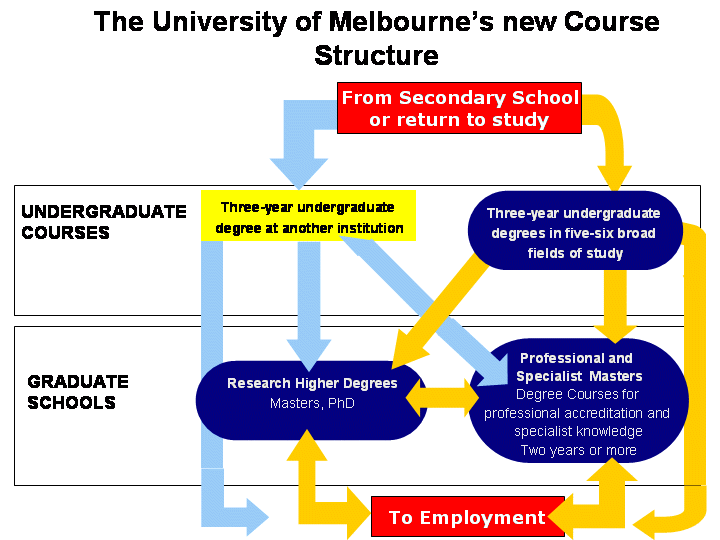|
|
|
|
|
|
|
News & Views item - April 2007 |
![]() One
Thing Steven Smith and Julie Bishop Have in Common is that in Describing the
Melbourne Model as Following the American System they Really Don't Know What
they're Talking About. (April 17, 2007)
One
Thing Steven Smith and Julie Bishop Have in Common is that in Describing the
Melbourne Model as Following the American System they Really Don't Know What
they're Talking About. (April 17, 2007)
When the vice-chancellor of The University of Melbourne, Glyn Davis undertook to revamp the curriculum, he pointed to such schools as The University of California, Berkeley as a model for what he was attempting to create at Melbourne -- after all it was a public university, has a similar number of students to Melbourne, and was and is ranked as one of the world's leading research universities.
And as the killer extreme makeover the Melbourne Model would produce a university predominately of graduate students, i.e. about two-thirds.
The university put out the following diagram of the Model.

Now whether or not Professor Davis' university eventually joins the likes of Berkeley, ranked 4th by the Institute of Higher Education, Shanghai Jiao Tong University, or even the University of Wisconsin, Madison, ranked, 16th remains to be seen, but as Vladimir and Estragon pointed out a year and a half ago it won't have anything to do with the contortions of developing the Melbourne Model.
First of all the "Cambridge Model" and the "Berkeley Model" are very different as regards the handling of their undergraduates, but in both cases their percentage of undergraduates is virtually identical, ~70%.
The table set out for Vladimir and Estragon in November 2005 would be little changed now and yet we have the shadow minister for education, Steven Smith quoted today as saying, "Moving to a graduate-style school as occurs in the US and Europe is the University of Melbourne's response to that challenge."
Well, see what you think. Check out the table below (formulated in November 2005).
| University | Type | Undergraduate students | Graduate students | % Undergraduates | SJTU* Ranking | Endowment US$ M |
|
University of Melbourne |
Public | 25,100 | 8,500 | 75 | 82 | -- |
| University of California, Berkeley | Public | 22,800 | 9.300 | 71 | 4 | 2,037 |
| University of Michigan, Ann Arbour | Public | 25,000 | 14,000 | 64 | 21 | 4,900 |
| Indiana University, Bloomington | Public | 27,800 | 7,900 | 78 | 87 | -- |
| Ohio State University, Columbus | Public | 37,400 | 13,100 | 74 | 43 | 1,600 |
| University of Wisconsin, Madison | Public | 29,000 | 13,000 | 69 | 16 | -- |
| University of Washington, Seattle | Public | 31,000 | 12,000 | 72 | 17 | 1,330 |
| University of Cambridge | Public | 11,800 | 4,700 | 71 | 2 | -- |
|
|
||||||
| Harvard University | Private | 6,650 | 13,000 | 34 | 1 | 25,900 |
| Stanford University | Private | 6,650 | 7,800 | 46 | 3 | 12,400 |
Mr Smith, however, did also say, "The approach taken by the University of Melbourne is not suitable for all Australian universities, indeed it may not be suitable for any other Australian university, but it is Melbourne's response to the pursuit of academic excellence and how it believes it can carve out a national and international role for itself."
The fact of the matter? Changing the "model" doesn't address the problems of second rate infrastructure, unwarranted administrative responsibilities and excessive teaching loads which leads to increasing difficulties in attracting and keeping staff of top quality.
Substantial increases in funding together with a reviving of governmental support does. That is the essence in the differing approaches of Cambridge's Allison Richard and Melbourne's Glyn Davis.
Whether or not Labor under Kevin Rudd, should they win office, will develop an environment conducive for overcoming the scarring the universities have received from 11 years of Coalition rule remains problematic.